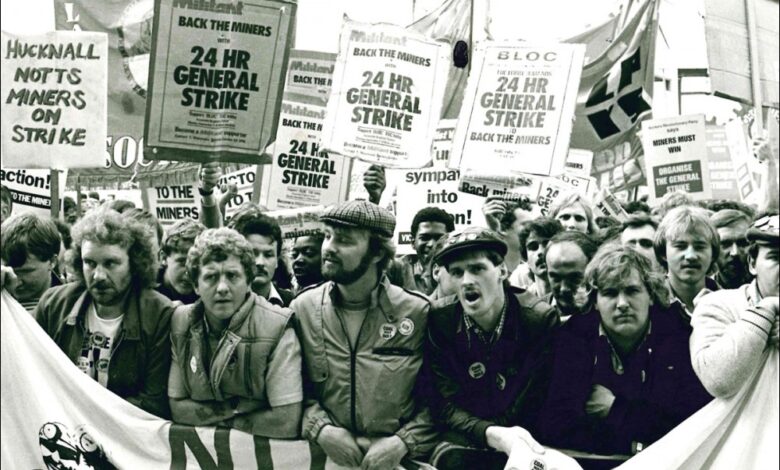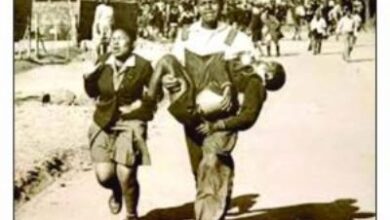The lessons of the heroic 1984-85 miners’ strike

Forty years ago, on 9 March 1984, Scottish miners began strike action. The Yorkshire National Union of Mineworkers (NUM) members had walked out on strike four days earlier, on March 5, against Tory government plans to impose a massive programme of pit closures. They saw this attack as the first step to a complete rundown of the mining industry. What was to become a year-long strike by miners across Britain had begun.
But there was even more to the miners’ strike. Former Tory chancellor Nigel Lawson admitted that Tory preparation for the strike was “just like rearming to face the threat of Hitler in the 1930s”.
They prepared meticulously and ruthlessly by stockpiling coal, beefing up the police’s powers and introducing anti-union laws. The Tories saw defeating the miners in 1984 as a means to destroy the working class’s collective strength.
As former political commentator Brian Walden described it, the miners’ strike was “a civil war without guns” – an all-out battle between workers and the ruling class.
Its effects still reverberate. Here we publish an edited extract of an article by Ken Smith – the author of the book a civil war without guns – the lessons of the 1984/85 miners’ strike. This article was first published on the 20th anniversary of the miners’ strike, in 2004.
Along the road of discovery, the new generation will have to cross some huge dungheaps of disinformation put there by critics of the miners’ stand from the right and left alike.
The ruling class and their apologists portray the strike as a doomed, futile attempt to preserve a dying industry led by a tactically inept Arthur Scargill.
Michael Ignatieff, seen as a cultural guru by the ruling class in 1984, wrote towards the end of the strike that “the miners’ strike is not the vindication of class politics but its death throes.”
Other critics, like New Labour minister Kim Howells – a former Communist and South Wales National Union of Mineworkers (NUM) research officer – converted to Blairism and disowned their role in the strike.
Even before the strike ended, Howells had hauled up the white flag saying: “The state is much better organised for taking on mass pickets than it was in the early 1970s… It is the hardest lesson any workforce has had to learn since 1926. The whole of the organised labour movement has to take a fresh look in future disputes.”
But for Howells, and many like him, taking a fresh look means drawing only negative conclusions, and abandoning the trade union ideals of struggle and solidarity – ideals the miners fought for so valiantly.
Even those on the left who solidly backed the miners are to this day intimidated by the miners’ defeat. They lack confidence to launch the kind of all-out struggles the miners did – to successfully turn the tables on 20 years of mostly uncontested attacks.
The miners’ strike was not only justified – the miners came closer to defeating Thatcher than they knew – but it also holds many vital lessons for trade unionists.
It was the longest lasting and most bitter industrial dispute of the second half of the 20th century in Britain. It had a huge impact on virtually every subsequent industrial and political development.
Police a political weapon
Over 27 million working days were lost in strike action in 1984 (mainly among miners). Over 11,300 miners and their supporters were arrested during the dispute. Over 5,600 stood trial and more than 100 were jailed, although 1,504 were released without charge. Over £60 million was raised for the miners, according to the Guardian newspaper. Warehouses full of food and toys were donated to the strikers and their families.
Seafarers were sacked and rail workers were victimised for taking solidarity action with the miners. Over 700 miners were sacked and not reinstated.
The Tories later admitted it cost nearly £6 billion to win the dispute, or £26,000 for every striking miner. This was a political attempt to break the power of the NUM. And, from 1985-95, the Tories’ continued war against the miners cost over £26 billion in redundancy and benefit payments, keeping pits mothballed and lost revenue from coal.
Thatcher and her cabinet were desperate for victory and prepared to go to great lengths to try and weaken or destroy the power of effective trade unionism, which they saw as an obstacle to their free-market policies.
For the first time in a post-war national strike the police were openly used as a political weapon. Provocateurs and spies were deployed – and the state benefits system used to try and starve the miners back.
Despite the extraordinary lengths the Tories went to, by October 1984, six months into the strike, the future of Thatcher’s government hung in the balance – when there were less than six weeks’ coal stocks.
The proposed strike by the pit supervisors’ union, Nacods, threatened to close down all working pits in the Midlands at this time. Later, Nacods shamefully called off the strike for a shoddy deal which the Tories later reneged on.
So, the NUM had to battle on alone. Despite the odds, they came within a whisker of winning. Ten years after the strike, Frank Ledger, the Central Electricity Generating Board director of operations, recounted how they had only planned for a six-month strike and that the situation at this time was verging on the “catastrophic”.
Former electricity board chairman Sir Walter Marshall spelt out what this meant: “Our predictions showed on paper that Scargill would win certainly before Christmas. Margaret Thatcher got very worried about that… I felt she was wobbly”.
Thatcher confirmed this herself nine years later: “We had got so far and we were in danger of losing everything because of a silly mistake. We had to make it quite clear that if it was not cured immediately then the actual management of the Coal Board could indeed have brought down the government. The future of the government at that moment was in their hands and they had to remedy their terrible mistake.”
Ultimately, the key factor that defeated the miners was not their lack of militant spirit in facing the most sustained vicious state onslaught on them and their families, nor was it lack of support from the wider ranks of the working class or even the mistakes that some NUM leaders made at national and area level – although some were of fundamental importance at later stages of the strike.
The crucial factor in the strike’s ultimate defeat was the treacherous, cowardly role of the trade union and Labour Party leaders, who consciously sabotaged the possibility of miners’ victory.
After Labour’s 1983 election defeat, right-wing trade union leaders were pursuing a policy they called ‘new realism’ – code for retreating in the face of the class enemy without firing a shot in retaliation. Labour leader Neil Kinnock was also afraid of a rising tide of militancy in the event of a miners’ victory, and he didn’t want to see militancy pay, particularly not if he was prime minister.
They used the absence of a national miners’ ballot and the fact that a section of miners were still working to turn their back on the 130,000 miners who were striking.
They refused to deliver the effective solidarity action that could have brought the miners victory, a victory which would have benefited the whole working class against the detested Thatcher.
Bitter blow
The miners’ defeat, along with the economic upswing of the late 1980s, set in motion a complex and difficult period in Britain, consolidating a massive shift to the right at the top of the labour movement.
Labour and trade union leaders meekly accepted anti-union legislation and generally abandoned any pretence of struggle against industrial run-down and privatisation.
It was a bitter blow for those miners and their families who struggled. Their jobs are gone for ever and their communities turned into industrial wastelands with social devastation following for many.
Had they won, the whole course of history would have changed. Thatcher and her government would have resigned and most likely a Labour government would have come to power.
The pit-closure plan would have been dropped and, under pressure from a confident working class, even a Kinnock Labour government would have had to carry through some measures in favour of the working class, perhaps being compelled to abolish the Tory anti-union laws.
The miners’ strike politicised a generation of young socialists. Over a quarter of a million school students went on strike just a month after the strike, inspired by the example of the miners and led by supporters of Militant, the Socialist Party’s forerunner. It also temporarily produced a massive shift to the left on many issues in society.
Immediately after the strike, Tory ministers privately fumed at how little goodwill their victory had brought them.
Had the miners not struggled as they did, many other anti-working-class measures would have been introduced earlier than they were.
But, eventually, dizzy with her own success, Thatcher began a policy of deindustrialisation of British industry and further impoverishment of working class and middle-class people.
Lessons of strike
Crucial questions arise from the strike: the role of mass picketing; democracy and leadership within the trade unions; the state; how to organise solidarity action; the role of left trade union leadership; what economic alternative should trade unionists and socialists put when an industry is claimed to be declining and, crucially, what programme and strategy for the trade unions is applicable today.
New generations will return to the lessons of the strike to ensure they are better equipped to win their own industrial battles and succeed in the socialist struggle to change society.
But, the most important lesson the miners’ strike taught the generation who lived through it is the willingness of working-class people to struggle and try to change society. It is still relevant today.
Timeline of the strike
November 1983
National Coal Board confirms 49 pits will close due to ‘exhausted reserves’.
March 1984
5 – Yorkshire miners stop work over proposed accelerated closure of Cortonwood and Bulcliffe Wood. Yorkshire NUM calls total stoppage from 12 March.
6 – Scottish area NUM calls strike from 9 March.
8 – NUM national executive declares strikes in Yorkshire and Scotland official, and any other area “which takes similar action”.
April 1984
19 – NUM special delegate conference supports action in all British coalfields. Resolutions for a ballot overwhelmingly rejected.
May 1984
29 – 5,000 pickets at Orgreave. Riot police deployed for the first time.
30 – Arthur Scargill arrested at Orgreave.
June 1984
6 – 10,000 pickets at Orgreave: 93 arrests; 73 police and hundreds of pickets injured.
18 – 7,000 pickets take on 4,000 police in the Battle of Orgreave.
July 1984
South Wales NUM fined £50,000 for contempt of court, refuse to pay.
August 1984
1 – Mass demonstration outside South Wales NUM in Pontypridd against threat of sequestration.
16 – £707,000 seized by sequestrators from South Wales NUM accounts.
October 1984
1-5 – Labour Party conference backs the miners.
4 – NUM fined £200,000 for contempt.
25 – Proposed Nacods strike over colliery closure review procedure called off.
25 – Sequestrators appointed to seize NUM funds.
November 1984
13 – TUC general secretary, Norman Willis, confronted by hangman’s noose at miners’ rally in South Wales.
December 1984
14 – Energy minister, Peter Walker, rejects further talks.
February 1985
20 – NUM accepts review procedure, as agreed by Nacods, and asks for talks with no preconditions.
March 1985
3 – NUM special delegate conference votes 98-91 to return to work without an agreement or amnesty.
5 – Miners return to work behind brass bands, with their supporters.



